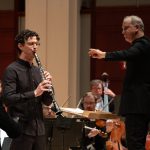March 17, 18 & 20, 2022
Atlanta Symphony Hall, Woodruff Arts Center
Atlanta, Georgia – USA
Nathalie Stutzmann, conductor; Martina Janková, soprano; Sara Mingardo; mezzo-soprano; Kenneth Tarver, tenor; Burak Bilgili, bass.
Richard STRAUSS: Death and Transfiguration
Ukrainian State Anthem: “The glory and freedom of Ukraine have not yet perished”
Wolfgang Amadeus MOZART: Requiem
Mark Gresham | 21 MAR 2022
Sometimes events unexpectedly put their mark upon musical programming. That was the case with the most recent concerts by the Atlanta Symphony Orchestra and Chorus.
When the ASO announced its 2021-22 season at noon on May 6, 2021, the published program for these concerts was Tod und Verklärung (“Death and Transfiguration”) by Richard Strauss and W.A. Mozart’s Requiem, to be conducted by Nathalie Stutzmann. She would later be publicly named ASO music director designate in October. The program, which Stutzmann described as “built upon the idea of how you can see life after death,” remained unchanged except for one addition: The National Anthem of Ukraine.
On February 24, 2022, Russia invaded Ukraine. The tragic conflict is ongoing, in our consciousness daily through the lens of 21st-century communications and media. The visceral and the emotional impact is immediate, even if much of what unfolds day after day may become more fully understood only in retrospect.
The two works by Strauss and Mozart in Thursday’s concert took on immense extra meaning in that fateful context, and the Ukrainian National Anthem, posited between them, shed its light on them “[a]s our prayer for an end to the conflict and hope for the goodness in humanity to rise above all.”
The ASO and Chorus, led by Stutzmann, dedicated the performance of Mozart’s Requiem to those who have lost their lives in Ukraine.
A portion of the concert’s proceeds was donated to the International Committee of the Red Cross’ Ukraine relief efforts, and the ASO has encouraged additional donations through this weblink: www.icrc.org/en/donate/ukraine
That phrase I used four paragraphs ago, “may only become fully understood in retrospect,” also applies to the programmatic story that underlies the tone poem Tod und Verklärung, Op. 24, by Richard Strauss, which opened the concert.
Completed on November 18, 1889, Tod und Verklärung musically depicts the death of an artist. As the work opens (“Largo”), he lies dying; the struggle between life and death (“Allegro molto agitato”) offers him no absolution. Memories of his life — innocent childhood, efforts of young manhood struggles, triumphs of his mature adulthood — all pass through his mind (“Meno mosso”), then at the end (“Moderato”), he is granted a longed-for transcendental spiritual transfiguration “from the infinite reaches of heaven.”
What interested me more than Tod und Verklärung itself was hoping to observe what Stutzmann brought to the orchestral table, relative to the Verdi and Tchaikovsky works she led in her previous ASO appearance back in October. At most, I want to say that it adds to my intuitions expressed in that review, even if not so clearly. Even more so implications for the Mozart Requiem, which we shall get to shortly. But I also felt Strauss’ musical portrait of the conquest of the artist over life struggles into enlightened transcendence has some parallels to the more pragmatic one of the Ukrainian National Anthem: the triumph of liberty snatched from the jaws of oppression. You might say the latter was the more attractive message for me.
The Ukrainian National (or State) Anthem is Ще не вмерла України і слава, і воля (“The glory and freedom of Ukraine have not yet perished”).
Here are the words in Ukrainian:
Ще нам, браття молодії, усміхнеться доля.
Згинуть наші воріженьки, як роса на сонці.
Запануєм і ми, браття, у своїй сторонці.
Душу й тіло ми положим за нашу свободу,
І покажем, що ми, браття, козацького роду.
An here is a compiled translation in English:
Fate will smile on us, young brothers.
Our enemies will fade, like dew in the sun.
Let us, brethren, rule in our homeland.
We will lay down our souls and bodies for our freedom,
And we will show that we, brothers, are of Kozak kin.
It is perhaps worth considering that the final two words, translated as “Kozak kin” implies “family of free people.” The Ukrainian “Kozak” (козак, more familiarly Cossack for English speakers) is a loan word of Turkic origin, akin to Volga Tatar “kazak” (“free person”).
Let’s now cut to the chase with the final work on the program for which was most eagerly awaited. Was this performance of Mozart’s Requiem a success? The short answer is yes. But an unequivocal success? Well, no.
There is far too much detail that one can discuss or argue over, both pro and con, to place into exposition here, much less debate.
Most importantly, the advent of Stutzmann’s impending directorship of the ASO’s musical forces is an evident change of compass that will flower much more readily in the orchestra than in the chorus — and I say that respectfully as a long-ago former member of the ASO Chorus.
The orchestra has ongoing encounters with different guest conductors on the podium throughout their season. As part of their professional craft, they adapt more quickly to unfamiliar personalities as well as new musical demands on their highly honed skills.
A chorus, however good, reorients itself to new directions a little more slowly, like turning the Queen Mary. Especially one with such a well-defined legacy of aesthetics and technique over many decades, as does the Atlanta Symphony Orchestra Chorus.
In the heady days when Robert Shaw was ASO music director, and the years that followed as music director emeritus and conductor laureate, he had the unique luxury of preparing the ASO Chorus for himself to conduct in performance. After Shaw’s death, Norman Mackenzie became director of choruses for the ASO and direct heir of the Shaw techniques and that lean, rhythmically-driven, energized American choral sound. He has done tremendously well with sustaining the core legacy and adapting it to the visions of other conductors.
But unlike Shaw, he has been tasked with what most directors of symphony choruses face: primarily preparing the body of singers only for another conductor to take the podium and lead. And they may have a different vision of the sound, expression, and aesthetic they want, as with both principal guest conductor Donald Runnicles and most recent music director Robert Spano. That is a more cooperative collegial endeavor which is, quite frankly, the norm in the symphonic world.
There are also other schools of choral technique in that world beyond that of Mr. Shaw, which is too easy to forget if your chorus and audience have become accustomed to one approach over decades, however iconic. I learned long ago there are well over a half dozen different schools of choral practice in the United States alone. That includes at least two notably appropriated from British tradition. Some I like very well, some others I, quite frankly, despise. And that doesn’t even speak of the variety of continental European traditions. Here, in Atlanta, it’s simply a fact that Shaw’s long and looming shadow has dominated for half a century.

The Mighty ASO Chorus and soloists join with the orchestra in performing Mozart’s “Requiem.” (credit: Raftermen)
Now comes two critical factors: first, an impactful hiatus for the ASO Chorus caused by the COVID-19 pandemic that shut down its rehearsals and performances for a year and a half. The other factor has been the appointment of Nathalie Stutzmann as the ASO’s new music director, officially beginning with the upcoming 2022-23 season, and the fact she is not only a conductor but also a contralto soloist. You don’t have that kind of twin-edged profession and not come away with a strong personal sense of what you want from a chorus.
Two previous opportunities for Stutzmann to conduct the ASO Chorus had to be scrapped: the first because she became indisposed, the next because of the COVID- pandemic. So this performance of Mozart’s Requiem became the crucial event to discover how what she was asking for in Tchaikovsky’s Symphony No. 5, in terms of phrasing, expression, musical vision, and the like, might play out with the ASO Chorus — fundamental elements beyond differences in the two composers’ styles.
What we got on Thursday was what I believe is just the beginnings of this luxury cruise ship of a chorus making a turn, inevitably a slow one with a wide turning radius. A change in its inner compass. But despite all of the observable evidence in Thursday’s performance, this will be a long process. Word from backstage says that the chorus is enamored with Stultzmann. That is to great advantage in what will be a process rather than a sudden choral transfiguration, even with a charismatic conductor like Stutzmann as the trimtab that ultimately steers the ship.
It will take time, but the ensemble will ultimately go with her vision of where she wants it to go. (Although that must be the subject of another essay entirely.). My intuitive feeling about this is palpable.
I could argue for and against all sorts of details about Stultzmann’s approach to the Requiem itself: for one, questionably-fast tempos in places but simultaneously a surprising nimbleness of the chorus in the execution of rapid melismatic passages at that pace. There was a presence of curious accents and articulations where the full choral-orchestral score has none, and I can find no explicable reason (in my opinion) for them to be inserted based upon the sung text. Many more pros and cons could be debated, mostly on one’s experiences with the Requiem and matters of musical taste.
What bothered me more was the placement of the quartet of soloists (soprano Martina Janková, mezzo-soprano Sara Mingardo, tenor Kenneth Tarver and bass Burak Bilgili) behind the orchestra. I felt that turned much to their disadvantage, at least from my very good seat in the hall. The video stream, which was still available on-demand the next day (and which I viewed several times), was much better for them, but then audio recording mics were placed near the quartet, so the miracle of audio engineering played its role. I believe that these soloists would have fared much better had they been at the front of the stage, and the difference would have delighted the audience as well.
With the video to replay yet again if I wish (and score in hand) there is still much to be fathomed with respect to not just this performance, but what is surely going to be a new and different era, not just for the orchestra, but possibly even more so for the ASO Chorus. Not right away for the latter, but in good time.
So I have to say that this performance of Mozart’s Requiem was reasonably successful, but for the more critical ear an unfinished work that left more questions hanging in the air than it answered. ■
EXTERNAL LINKS:
- Atlanta Symphony Orchestra: aso.org
- Nathalie Stutzmann: nathaliestutzmann.com

Mark Gresham is publisher and principal writer of EarRelevant. he began writing as a music journalist over 30 years ago, but has been a composer of music much longer than that. He was the winner of an ASCAP/Deems Taylor Award for music journalism in 2003.
 Tine Thing Helseth brings fire and finesse to trumpet concertos by Arutiunian, Penderecki, and Weinberg • 24 Oct 2025
Tine Thing Helseth brings fire and finesse to trumpet concertos by Arutiunian, Penderecki, and Weinberg • 24 Oct 2025 Camerata Nordica Octet brings Scandinavian color and classical clarity to Hodgson Hall • 21 Oct 2025
Camerata Nordica Octet brings Scandinavian color and classical clarity to Hodgson Hall • 21 Oct 2025





.png)